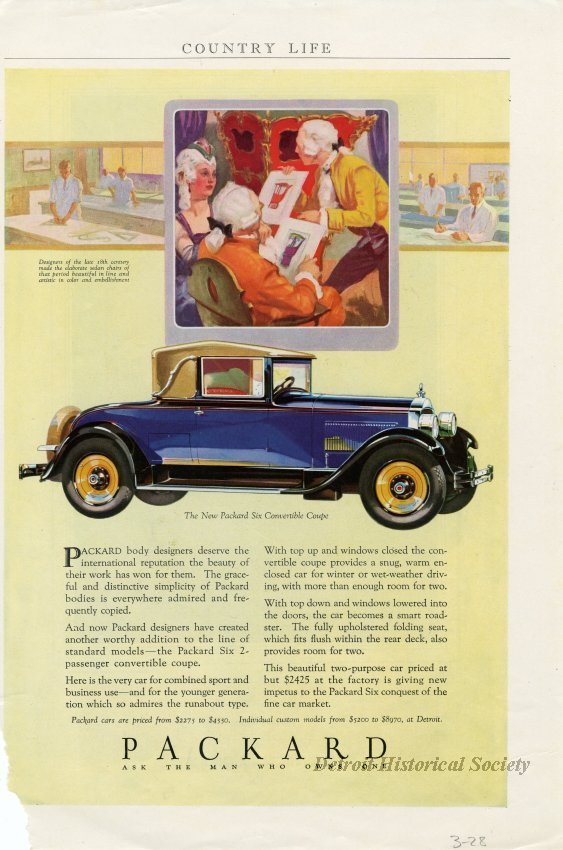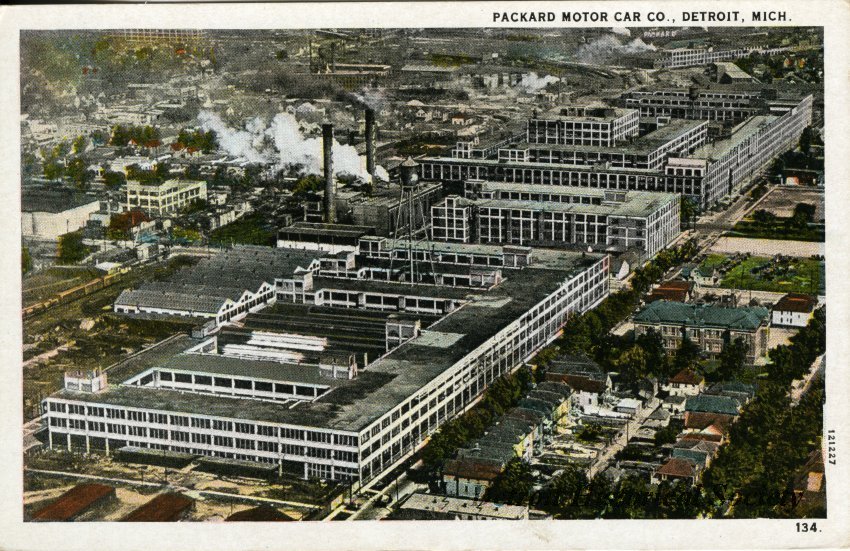The Packard Motor Car Company began and ended outside Detroit but experienced its heyday in the city. Considered the premiere luxury car of its era, the Packard became the preferred car of celebrities and movie stars. Packard also took a leading role in the changeover to defense production during World War II.
The first Packard was made in 1899 under the New York and Ohio Company, founded by brothers William and James Packard in Warren, Ohio. Detroiter Henry Bourne Joy bought a Packard while in New York City and was so impressed by it that, after visiting the Packard brothers in Ohio, he convinced friends Truman Newberry, Russell Alger, Jr., Phillip McMillan, Dexter Ferry, Jr., Joseph Boyer and Charles DuCharme, all from some of the city’s wealthiest families, to invest in the company, now called the Ohio Automobile Company.
In 1902 the name of the business was changed to the Packard Motor Car Company, and it moved to Detroit the next year. Architect Albert Kahn was hired to design the factory on East Grand Boulevard, that would start with ten buildings and expand to a complex of 40. This initiated Kahn’s notable career as a factory architect using reinforced concrete, allowing him to design, as exemplified in Packard Factory Building No. 10, the window-filled, wide-open areas that would be the hallmark of factories for years to come.
James Packard remained president of the company until 1909, when Henry Joy, who had been general manager, took over, holding the position until 1916. Packard became known for its racing cars, for popularizing the 12-cylinder engine, and for its airplane engines. Chief engineer Jesse Vincent and Alvan McCauley, who followed Henry Joy as president, were both instrumental, along with Joy, in the company’s success. “Ask the Man Who Owns One” became Packard’s signature, along with the car’s tombstone-shaped grille.
Packard held several notable achievements. Packard was the first car company to use a steering wheel, rather than a tiller-type control. They built the Liberty Engine, used In World War I aircraft and later adapted as a successful marine engine used by motorboat racer Gar Wood. Packard created the “Gray Wolf” - the first race car in the U.S. to go a mile a minute. During World War II, Packard built 55,000 airplane engines, utilizing the Rolls-Royce Merlin engine. The luxurious Packard Twin-Six (produced 1915-1923), and its successor the Packard Twelve, became the favorite of movie stars, kings, and presidents.
In 1954 the last Packard was built at the factory on East Grand Boulevard, under the auspices of the Studebaker-Packard Company, Packard having bought Studebaker that same year. In 1956 the company moved to South Bend, Indiana, while a plant on Connor Avenue in Detroit built what is described as the “last true Packard,” the Packard Predictor. The South Bend Studebaker plant made name-only Packards for another two years.
Since closing, the 40-acre Packard site has fallen into disrepair, becoming a prominent example of Detroit’s controversial “ruin porn.” Over the years various attempts have been made to repurpose some of the buildings, but none have come to fruition and some buildings have been torn down by the city. The iconic bridge over East Grand Boulevard, adorned by a clock, collapsed in 2019.
The National Automotive History Collection of the Detroit Public Library has the Packard Company photographic archives with more than 3,000 images online.

